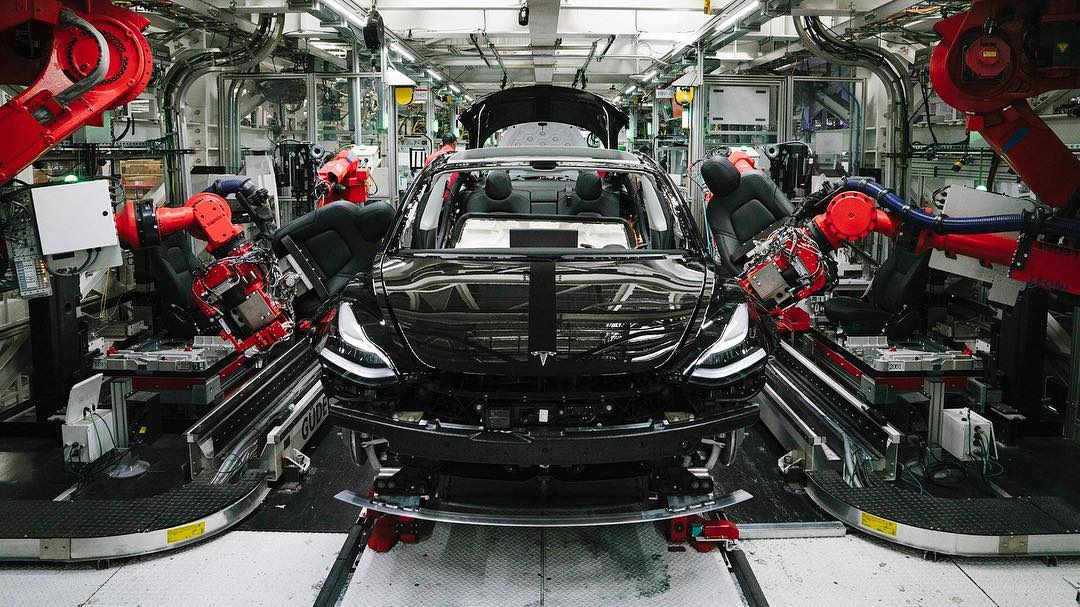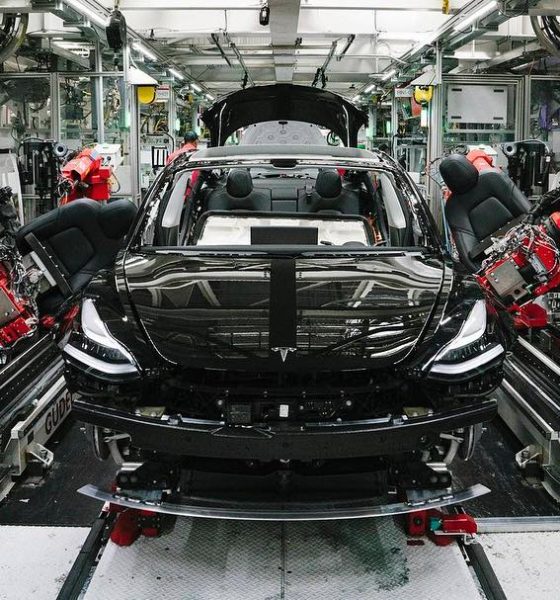

Investor's Corner
Tesla Mid-Range Model 3 production ramp kicks off with 4.5k RWD VIN registrations
As Tesla heads towards its earlier-than-expected Q3 2018 earnings call, the company’s Model 3 production ramp continues to show signs that it is going smoothly. Just yesterday, Tesla registered another large batch of 4,500 new Model 3 VINs, all of which appear to be RWD versions of the electric sedan. Tesla had also registered 38,211 Model 3 since the beginning of October, setting up the company for what could very well be a record month in terms of new Model 3 VIN registrations.
#Tesla registered 4,500 new #Model3 VINs. ~0% estimated to be dual motor. Highest VIN is 156129. https://t.co/cw9lfjMZDw
— Model 3 VINs (@Model3VINs) October 22, 2018
While Tesla’s VIN registrations do not specifically list the cars’ Long Range or Mid Range battery, the company’s push for the MR version and the absence of the LR variant in the Model 3 configurator do suggest that the latest VIN filings correspond to the Mid Range Model 3 RWD. With this new batch, Twitter’s Model 3 VIN tracking group @Model3VINs notes that Tesla had registered a total of 156,129 Model 3 VINs to date.
Tesla’s new Model 3 VIN filings come at a time when the company is pushing the electric car’s newest variant — the Mid Range Model 3 RWD — to reservation holders. Musk seems to have teased the vehicle on the social media platform a day before it was officially announced, stating that a “lemur” was coming. Neither Tesla nor Elon Musk has announced the reasons behind the lemur reference, though the little primate might be a clever play on the LEMR variation of the electric car (Limited Edition Mid Range, perhaps?).
Considering that the Mid Range RWD variant is a vehicle that puts Tesla one step closer to the $35,000 Standard trim Model 3, the new electric car variant could very well see a lot of demand. The Mid Range Model 3 RWD currently has an estimated delivery time of 6-10 weeks, after all, which would allow buyers to take delivery of the vehicle at a time when Tesla’s full $7,500 Federal Tax Credit is still in full effect. Taking the $7,500 tax credit and estimated gas savings into account, Tesla’s Mid Range Model 3 RWD has an estimated cost of ownership in the $33,200 range.
Tesla’s decision to offer a Mid Range variant to the Model 3 could be seen as a strategic move by the electric car maker. The vehicle, after all, takes advantage of its remaining $7,500 federal tax credit to lower the vehicle’s total cost of ownership. Elon Musk’s later tweets also revealed that the introduction of the new electric car variant would likely not weigh down the Model 3 production ramp either, as the Mid Range Model 3 RWD uses the same battery pack as the Long Range RWD version, albeit with fewer battery cells.
It’s a long range battery with fewer cells. Non-cell portion of the pack is disproportionately high, but we can get it done now instead of ~February
— Elon Musk (@elonmusk) October 18, 2018
The Mid Range Model 3 RWD represents a $4,000 price savings from the Long Range RWD variant that starts at $49,000 before incentives. There are some performance compromises with the Mid Range Model 3 RWD, though, in the form of a 0-60 mph time of 5.6 seconds, a top speed of 125 mph, and a driving range of 260 miles per charge. In comparison, the Long Range Model 3 RWD has a 5.1-second 0-60 time, a top speed of 140 mph, and a range of 310 miles per charge.
The introduction of the Mid Range Model 3 RWD could ultimately be a way for Tesla to boost its production and delivery numbers further this Q4. The company set the bar high in Q3 with its record deliveries and production figures, after all, and it would take even more impressive numbers for the company to become profitable in the fourth quarter. With this in mind, the Mid Range Model 3 RWD could very well be the catalyst for Tesla’s profitability this Q4, due to its potential to attract budget-conscious reservation holders waiting for low-cost versions of the vehicle.
Tesla has announced that it would be holding its Q3 earnings call on Wednesday, October 24, 2018. The live Q&A session is set for 3:30 p.m. Pacific Time (6:30 p.m. Eastern Time) to accommodate requests from several analysts.

Investor's Corner
Tesla stock closes at all-time high on heels of Robotaxi progress

Tesla stock (NASDAQ: TSLA) closed at an all-time high on Tuesday, jumping over 3 percent during the day and finishing at $489.88.
The price beats the previous record close, which was $479.86.
Shares have had a crazy year, dipping more than 40 percent from the start of the year. The stock then started to recover once again around late April, when its price started to climb back up from the low $200 level.
This week, Tesla started to climb toward its highest levels ever, as it was revealed on Sunday that the company was testing driverless Robotaxis in Austin. The spike in value pushed the company’s valuation to $1.63 trillion.
Tesla Robotaxi goes driverless as Musk confirms Safety Monitor removal testing
It is the seventh-most valuable company on the market currently, trailing Nvidia, Apple, Alphabet (Google), Microsoft, Amazon, and Meta.
Shares closed up $14.57 today, up over 3 percent.
The stock has gone through a lot this year, as previously mentioned. Shares tumbled in Q1 due to CEO Elon Musk’s involvement with the Department of Government Efficiency (DOGE), which pulled his attention away from his companies and left a major overhang on their valuations.
However, things started to rebound halfway through the year, and as the government started to phase out the $7,500 tax credit, demand spiked as consumers tried to take advantage of it.
Q3 deliveries were the highest in company history, and Tesla responded to the loss of the tax credit with the launch of the Model 3 and Model Y Standard.
Additionally, analysts have announced high expectations this week for the company on Wall Street as Robotaxi continues to be the focus. With autonomy within Tesla’s sights, things are moving in the direction of Robotaxi being a major catalyst for growth on the Street in the coming year.
Elon Musk
Tesla needs to come through on this one Robotaxi metric, analyst says
“We think the key focus from here will be how fast Tesla can scale driverless operations (including if Tesla’s approach to software/hardware allows it to scale significantly faster than competitors, as the company has argued), and on profitability.”

Tesla needs to come through on this one Robotaxi metric, Mark Delaney of Goldman Sachs says.
Tesla is in the process of rolling out its Robotaxi platform to areas outside of Austin and the California Bay Area. It has plans to launch in five additional cities, including Houston, Dallas, Miami, Las Vegas, and Phoenix.
However, the company’s expansion is not what the focus needs to be, according to Delaney. It’s the speed of deployment.
The analyst said:
“We think the key focus from here will be how fast Tesla can scale driverless operations (including if Tesla’s approach to software/hardware allows it to scale significantly faster than competitors, as the company has argued), and on profitability.”
Profitability will come as the Robotaxi fleet expands. Making that money will be dependent on when Tesla can initiate rides in more areas, giving more customers access to the program.
There are some additional things that the company needs to make happen ahead of the major Robotaxi expansion, one of those things is launching driverless rides in Austin, the first city in which it launched the program.
This week, Tesla started testing driverless Robotaxi rides in Austin, as two different Model Y units were spotted with no occupants, a huge step in the company’s plans for the ride-sharing platform.
Tesla Robotaxi goes driverless as Musk confirms Safety Monitor removal testing
CEO Elon Musk has been hoping to remove Safety Monitors from Robotaxis in Austin for several months, first mentioning the plan to have them out by the end of 2025 in September. He confirmed on Sunday that Tesla had officially removed vehicle occupants and started testing truly unsupervised rides.
Although Safety Monitors in Austin have been sitting in the passenger’s seat, they have still had the ability to override things in case of an emergency. After all, the ultimate goal was safety and avoiding any accidents or injuries.
Goldman Sachs reiterated its ‘Neutral’ rating and its $400 price target. Delaney said, “Tesla is making progress with its autonomous technology,” and recent developments make it evident that this is true.
Investor's Corner
Tesla gets bold Robotaxi prediction from Wall Street firm
Last week, Andrew Percoco took over Tesla analysis for Morgan Stanley from Adam Jonas, who covered the stock for years. Percoco seems to be less optimistic and bullish on Tesla shares, while still being fair and balanced in his analysis.

Tesla (NASDAQ: TSLA) received a bold Robotaxi prediction from Morgan Stanley, which anticipates a dramatic increase in the size of the company’s autonomous ride-hailing suite in the coming years.
Last week, Andrew Percoco took over Tesla analysis for Morgan Stanley from Adam Jonas, who covered the stock for years. Percoco seems to be less optimistic and bullish on Tesla shares, while still being fair and balanced in his analysis.
Percoco dug into the Robotaxi fleet and its expansion in the coming years in his latest note, released on Tuesday. The firm expects Tesla to increase the Robotaxi fleet size to 1,000 vehicles in 2026. However, that’s small-scale compared to what they expect from Tesla in a decade.
Tesla expands Robotaxi app access once again, this time on a global scale
By 2035, Morgan Stanley believes there will be one million Robotaxis on the road across multiple cities, a major jump and a considerable fleet size. We assume this means the fleet of vehicles Tesla will operate internally, and not including passenger-owned vehicles that could be added through software updates.
He also listed three specific catalysts that investors should pay attention to, as these will represent the company being on track to achieve its Robotaxi dreams:
- Opening Robotaxi to the public without a Safety Monitor. Timing is unclear, but it appears that Tesla is getting closer by the day.
- Improvement in safety metrics without the Safety Monitor. Tesla’s ability to improve its safety metrics as it scales miles driven without the Safety Monitor is imperative as it looks to scale in new states and cities in 2026.
- Cybercab start of production, targeted for April 2026. Tesla’s Cybercab is a purpose-built vehicle (no steering wheel or pedals, only two seats) that is expected to be produced through its state-of-the-art unboxed manufacturing process, offering further cost reductions and thus accelerating adoption over time.
Robotaxi stands to be one of Tesla’s most significant revenue contributors, especially as the company plans to continue expanding its ride-hailing service across the world in the coming years.
Its current deployment strategy is controlled and conservative to avoid any drastic and potentially program-ruining incidents.
So far, the program, which is active in Austin and the California Bay Area, has been widely successful.








